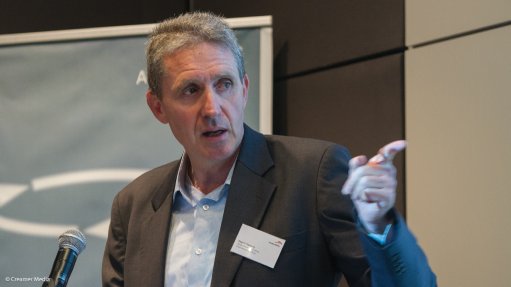
ArcelorMittal South Africa CEO Paul O’Flaherty
Photo by: Duane Daws
Steel producer ArcelorMittal South Africa (AMSA) signalled on Friday that it was aiming to reopen historically fraught iron-ore pricing negotiations with Kumba Iron Ore, with CEO Paul O’Flaherty describing the current cost-plus arrangement as unsustainable in light of dramatic declines in iron-ore and steel prices.
O’Flaherty even reported that AMSA was seriously investigating iron-ore importation options, which could be introduced as early as this year, starting with its Saldanha Steel mill, in the Western Cape. But he stressed that importation was not AMSA’s preferred option.
The JSE-listed steel group’s questioning of the pricing model came only a year-and-a-half into an arrangement that was unveiled in late 2013 following a protracted legal battle between the two companies.
The so-called “holistic” deal, which became effective on January 1, 2014, regulated the sale of 6.25-million tons of iron-ore a year from Kumba’s Sishen and Thabazimbi mines to AMSA’s steel mills in Gauteng, KwaZulu-Natal and the Western Cape.
The price was derived using the cost of production at Sishen’s dense media separation plant, plus a 20% margin and it was meant to endure for the life-of-mine of the giant Sishen mine, in the Northern Cape.
AMSA reported that, having benefited to the tune of R780-million from the agreement in the first half of 2014, “the inverse was achieved when iron-ore prices declined” to current levels of around $50/t. AMSA reported “extra costs” of R100-million for the second half of 2014 and R940-million in the first half of 2015.
The group’s iron-ore costs during the first half of 2015 declined by only 3%, while the export parity price (EPP) had fallen 23% during the period, with AMSA paying about $78/t for its ore.
O’Flaherty said that the gap between what it was being invoiced by Kumba and the EPP had widened to the point where “we have to sort our options out” over the coming six months.
“Our options are [either] we renegotiate this price, or we import iron-ore,” he told media and analysts during a presentation at the JSE in Sandton.
The group was already moving to test Australian ore at its Saldanha plant in the coming month and was putting plans in place to convert the full operation to imported ore by the fourth quarter of 2015.
Work was also under way on replacing the entire Kumba supply from 2016 onwards, which would require additional imports through Richards Bay, in KwaZulu-Natal, to service its Newcastle and Vanderbijlpark mills.
“It’s about survival,” O’Flaherty said, while acknowledging that AMSA was in a “weak” negotiating position with Kumba in light of the existing agreement. Nevertheless, he also argued that the steel group was a good client for Kumba, particularly in the current low-demand environment, and highlighted the fact that AMSA had no take-or-pay obligation to match Kumba’s supply obligation.
He, therefore, hoped that a solution could be found in the interest of both companies and the country, even if it represented temporary “relief” from the difficult market conditions.
“I would think what would worry Kumba is if they gave us a price decrease, would we then just make sure our prices don’t change – so they would just be transferring profit from them to us.
“[Therefore] the discussion we need to have with Kumba is ‘if you give us relief on the iron-ore price, we can give relief on the steel price’,” O’Flaherty outlined.
AMSA was in parallel talks with government on a “sustainable fair price model” which could incorporate a flow-through benefit of lower iron-ore costs to steel consumers. However, that model would only be extended in return for tariff protection and the designation of steel for local procurement.
KUMBA RESPONDS
However, Kumba argued that the existing long-term supply agreement would be beneficial to AMSA over the life-of-mine, highlighting that the price was also subject to a market price cap.
“Thus, AMSA will only pay a premium to market prices if Sishen’s costs as per the agreement are higher than market prices,” the company said in response to questions posed by Engineering News Online.
Kumba dismissed the contention that AMSA was currently paying a premium of 60% on iron-ore from Kumba.
“Once the market price cap is applied, the expense in AMSA’s accounts will – at $52/t (excluding the deferred stripping AMSA capitalised) – result in a price no more than 5% higher than EPP, but 26% below the import parity price based on the data for the first half of 2015.”
The miner stressed, too, that prices had been extremely volatile and depressed, which had resulted in Kumba pursing a reconfiguration to ensure long-term sustainability. These measures include retrenchments, capital expenditure cuts and the decision not to pay an interim dividend.
“During times of high iron-ore prices AMSA has derived significant benefit from Kumba. From 2001 to 2014, it is estimated that AMSA enjoyed a benefit in excess of R25-billion due to its supply agreements with Sishen Iron Ore Company.”
However, AMSA was also not convinced that Kumba’s planned closure of the Thabazimbi iron-ore mine was in the best interests of it, or South Africa. It would, therefore, seek to work with the Anglo American unit and the Department of Mineral Resources to extend the life of the Limpopo mine.
“We have a belief, from our side, that Thabazimbi is salvageable,” O’Flaherty averred.
“Yes, maybe it’s not a tier-one Anglo American mine, but that doesn’t mean you can’t have a profitable mine, with junior miners, with an offtake from us and save the jobs.”